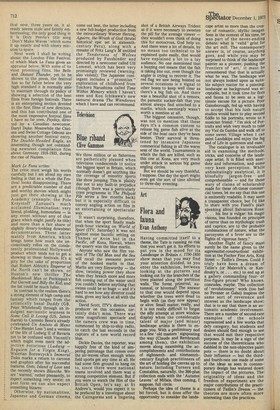Art
Flora and fauna
Evan Anthony
Having committed itself to a theme, the Tate is running no risk that you won't get it. Its efforts to put you in the mood for its Landscape in Britain c. 1750-1850 show mean that you may find your attention divided, as you enter the exhibition, between looking at the pictures and looking out for the branches of the trees planted along the partition walls. The forest primeval, autumnal, or hivernal? The answer to that one would depend upon whether the trees were dead to begin with (as they now appear) or alive. Small matter, really, and it is not really difficult to forget the silly attempt at store window display when the considerable talent of major (and minor) landscape artists is there to engage you. With a preliminary nod to a few 'old masters' signposting the way (Claude and Rembrandt among them), the exhibition moves along examining the accomplishments and contributions of eighteenthand nineteenthcentury English practitioners of the art of holding the canvas up to nature. Including Turners and Constables, naturally, the 300-plus collection ends with the 'Autumn Leaves' of Millais, thus coming, I suppose, full circle.
Perhaps the idea of theme is a' bit forced, but it does offer the opportunity to consider the lands cape artist as more than the creator of romantic, idyllic images. Seen in the context of his time, he was part of the never-ending debate: what is 'valid ' grist for the art mill. The contemporary answer is, of course, anything goes, and while you may be surprised to think of the landscape painter as a pioneer, pushing the frontiers of ' art,' it must be remembered that that is actuallY what he was. The landscape was not always looked upon as suitable subject matter for a painting; landscape as background was acceptable, but it took time for flora and fauna to be seen as a legitimate excuse for a picture. Poor Gainsborough, fed up with having to accept that his lush nature studies would have to play second fiddle to his portraits, wrote to a musician friend: " I'm sick of Portraits and wish very much to take my Viol da Gamba and walk off to some sweet Village when I can paint Landskips and enjoy the fag end of Life in quietness and ease.' The catalogue is an invaluable aid in examining the methods, tricks, and concerns of the landscape artist. It is filled with anecdote and information, and some very keen perception. While unhesitatingly analytical, it is blissfully jargon-free and comprehensible — and for those wary of claims of scholarshiP made for these oft-times commercial tomes, let me say that this one is eminently readable. It may seem a transparent choice, but I'd like to share with you Fuseli's plain speaking about Salvatore Rosa: " . . his line is vulgar: his magic visions, less founded on principles of terror than on mythologic trash and caprice, are to the probable combinations of nature, what the paroxysms of a fever are to the flights of vigorous fancy." Another flight of fancy must surely be the name given to the suprematist-constructivist exhibition at the Fischer Fine Arts, King Street — Tatlin's Dream. Could it truly have been a dream of Tatlin's (or Malevich's, or Kandinsky's, or. . . etc.) to end up at a gallery commanding fouror five-figure prices? Who knows, comrades, maybe. This collection of ' revolutionary ' work (too bad no Pevsner or Gabo) inspires the same sort of reverence and interest as the landscape show; that is to say that there is an automatic academic involvement. There are a number of second-rate examples of the schools represented and a few works that defy category, but students and dealers should find enough to see that would suit their respective purposes. It may be a sign of the success of the theoreticians who dabbled in the non-objective paint pots — there is no doubt about their influence — but the thirdand fourth-rate use made of some of the ideas as seen in contemporary design has watered down the impact of the pictures. The originality of ideas and the freedom of experiment are the major contributions of the practitioners of Tatlin's Dream — the theories are more often more interesting than the practices.










































 Previous page
Previous page